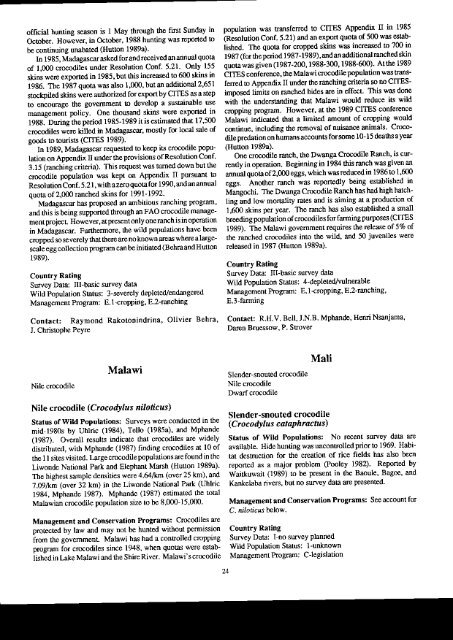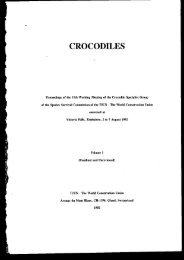size: 7451KB - Crocodile Specialist Group
size: 7451KB - Crocodile Specialist Group
size: 7451KB - Crocodile Specialist Group
Create successful ePaper yourself
Turn your PDF publications into a flip-book with our unique Google optimized e-Paper software.
official huntiog s€ason is I May lhrough the fusl Sunday in Dopulalion was tmnsfen€d to CITES Append ll in 1985<br />
October. However, in Ocbber, 1988 hunting *as lEponed !o G;solution Conf. 5.21) and an exponquolr o[ 500 was eslablished.<br />
The quoa for cropped skins was increased |o ?00 in<br />
be continuing unabaled (Hutton 1989a).<br />
ln 1985, Madagascar ssked fol and received an annual quota 198? (for $eperiod 1987-1989), and an additional Bnched skin<br />
of 1,000 crocodiles undor Resolution Conf 5.2l Only f55 ouo|2qa(qiven ( 1987-200, I q88' 300, 1988-600) Alttle 1989<br />
skins were exponed in 1985, bul this increased to 600 skins in it.Igs conterence. tle tutala w i crocodile population was nans'<br />
1986. The 1987 quota was also 1 ,000' but an additional 2'65 I ferrcd to Appendix II under the ranching crit€rja so no CITESimDosed<br />
limits on ranched hidos are in effect. This was done<br />
stockpiled skins were authorized for export by CITES as a s'ep<br />
to encoumge the govemment to develop a sustainable use with the understanding that Malawi would reduce its wild<br />
managcment policy. One thousand skins were expo(ed in ciopping program. However, at dle 1989 CITES conference<br />
1988. During the Priod 1985- 1989 it is e'stinated that l7'50o Malawi indicarcd that a limited amount of cropping would<br />
crocodiles were killed in Madagascar, mosdy fd local sale of continuo, including the rcmoval ofnuignc€ animals. Croco_<br />
coods to tourists (CITES 1989).<br />
dile paedation on humans accoun6 fol some l0- 15 deaths a yeal<br />
In 1989, Madagascare4uesled to keep its crocodile popularion<br />
on Appendix tr under the provisions of Resolrttion Conf One uocodtle ranch, the Dwanga <strong>Crocodile</strong> Ranch' is cur-<br />
(Hunon 1989a).<br />
3.15 (ranching criteria). This request was lrmed down bul the rently in oporation. Beginning in 1984 ihis ranch was given a,l<br />
crocodrle population was ke on Appedix II pursuant to annual quola of2,m0 eggs, which was reduced in 1986 to 1'600<br />
ResolutionCont. 5.2 t,withazetoquo(afor la90.andanannual eggs. Another ranch was reportcdly being established in<br />
ouola of 2.000 ranch€d skins f$ I94l'19y2.<br />
Mangochi. fie Dwanga <strong>Crocodile</strong> Ranch has had high hatchling<br />
and low monality rates and is aiming at a Foduction of<br />
Madagascar has proposed an ambiuous nnching program,<br />
and this is being supponed drough an FAO crocodile managemont<br />
pmjecl Howcver, atpres€nt only one nnch is in opdation breeding population of crocodiles for farning purposes<br />
1,600 skins per year. Th€ ranch has also established a small<br />
(CITES<br />
in Madagascar. Furthermoro, the wild popula[ons havc been<br />
cropped so severely that there aro no known areas where a largo_<br />
scale egg collection program can be initiated (Behra and Hutton<br />
r989).<br />
Country Rating<br />
Survey Data: Ill-basic survey alala<br />
WildPopulation Status: 3-severely depletcd/endangcred<br />
ManagcmenlProgram: 8.1'cropping,E.2-ranching<br />
1989). The Malawi govemmena requires the release of 5% of<br />
the ranched qocodiles into the wild, and 50 juveniles were<br />
releasod in 1987 (Hutton 1989a)<br />
Country Raaing<br />
Survey Data: Ill-basic s|lrvey data<br />
wild Population Slatus: 4-depleted/wlnerable<br />
Managcment hogmm: E.l{ropping, E.2-ranching'<br />
E.3'farming<br />
Conaact: Raymond Rakotonindrina, Olivier Behra' Contect: RHV Bell,JNB Mphando' Henri Nsanjama'<br />
J. Christophe Peyre Daren Bruessow. P Stover<br />
Nile crocodtle<br />
Malawi<br />
Slender'snouied crocodile<br />
Nile crocodile<br />
Dwarf crocodile<br />
Mali<br />
Nile crocodile (Crocodylus niloticus)<br />
Slender-snouted crocodile<br />
Status of Wild Populations: Surveys were conductcd in $e (C t o c o dJ lu s c ot ap h r ac tu s)<br />
mid-1980s by Uhlric (1984), Tello (1985a), and Mphande<br />
(1981. Overall results indicatc that crocodiles are widely Status of W d Populations: No recent survey dal, ar€<br />
distributed, with Mphande (1987) finding crocodiles at l0 of available. Hidc hunting wai urcontrolled pior to 1969. Habitat<br />
dcsEuction for the crealion of rice fields has also been<br />
dle 1 I sites visited. l-arge crocodile populalions are found in thc<br />
Liwonde National Park and Elephant Marsh (Hufon 1989a) reponod as a major problom (Pmley 1982). Reponed bv<br />
The highest sample densiries were 4.64,&m (over 25 km)' and Waitkuwait (1989) to be preent in (he Baoule, Bagoe' and<br />
7.09^m (over 32 km) in the Liwonde National Park (Uhlric Kankelaba nvers, but no sulvey daa are presented.<br />
1984, Mphande 198?). Mphandc (1987) cstimaled the lotal<br />
Malaw.ln crocodile population <strong>size</strong> to be 8,000'15,000. Manag€ment and Conservation Progrsms: See account for<br />
C. ^iloticus bebw.<br />
Management and Consarvation Progmms: <strong>Crocodile</strong>s are<br />
protected by law and may not be hunted without permrsslon Country Reting<br />
ftom the govcmmenL Malawi has had a controlled cropping Survey Datai I no survey Planned<br />
progmm for crocodiles since 1948, when quotas were establishcd<br />
in Lake Malawi and $e S hire Rivcr. Malawi's crocodilc ManagementPrograin:<br />
Wild Populatron Status: l-unknown<br />
Clegislation<br />
24

















